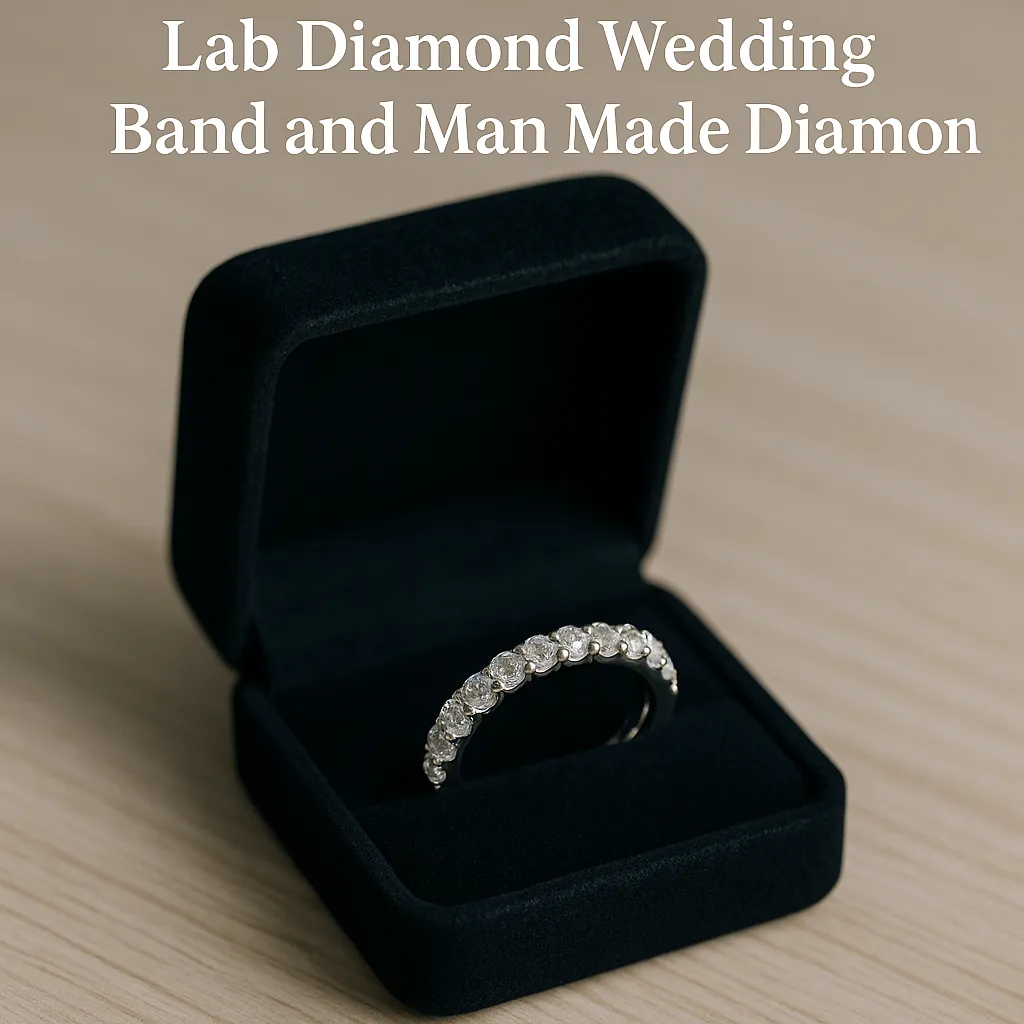The New Sparkle of Commitment: Lab Diamond Wedding Band and Man Made Diamonds
In an era when values, ethics, and sustainable choices weigh more heavily than ever, even the symbols of love and marriage are evolving. The centuries-old tradition of giving a diamond ring is being reinterpreted through new science and new ideals. Today, couples are choosing a lab diamond wedding band rather than a mined stone, embracing the era of man made diamonds. This shift is not just a fashion trend—it’s a reflection of deeper human concerns: our relationship with the environment, fairness, cost, and meaning.
A Love Story Reimagined
Imagine this: A young couple, Aisha and Omar, sit across from each other at a small café. Omar slides a finely polished ring box to her. Inside lies a graceful wedding band, centered with a brilliant stone that sparkles like fire. Aisha’s eyes widen: “Is this a diamond?” she asks. Omar nods, “Yes—but it’s grown in a lab.” She pauses, surprised, then smiles. “It’s beautiful, and you cared to choose thoughtfully.”
This simple exchange captures what many couples feel today. The choice to wear a lab diamond band is not about rejecting tradition; it is choosing a diamond that aligns with modern values.
What Are “Man Made Diamonds”?
First, let’s clarify terms. Man made diamonds (also called lab-grown, lab-created, or cultured diamonds) are real diamonds in every physical, chemical, and optical sense—but they are created in a controlled laboratory environment instead of forming naturally over billions of years underground.
Two primary methods produce these diamonds:
HPHT (High Pressure High Temperature): This method mimics the extreme pressure and temperature conditions deep inside the Earth. A “seed” diamond is placed in carbon and then subjected to immense pressure and heat, causing more diamond to grow around it.
CVD (Chemical Vapor Deposition): A more recent technique where carbon-rich gases are introduced in a vacuum chamber, depositing carbon atoms onto a seed diamond layer by layer under controlled conditions.
Because lab diamonds are genuine diamonds, they share the same brilliance, hardness, and sparkle as mined diamonds—meaning they pass the same gemological tests and, in effect, look indistinguishable to the naked eye.
Why Choose a Lab Diamond Wedding Band?
1. Ethical and Conflict-Free Origins
One of the strongest motivations for many is avoiding the human cost associated with some diamond mining operations—conflict diamonds, unfair labor practices, and environmental degradation. A lab diamond wedding band offers assurance that no people or ecosystems were harmed in its making.
2. Greater Affordability
Because lab-grown diamonds skip the expensive and unpredictable process of extraction, markups, and transport, they often cost significantly less than equivalent natural diamonds. Couples can often afford a higher grade or larger stone for the same budget.
3. Transparency and Traceability
Laboratories maintain records about each diamond’s origin, making traceability easier. Some manufacturers label or inscribe the diamond so its origin is visible under magnification.
4. Environmental Benefits (with caveats)
On paper, lab-grown diamonds avoid land destruction, pit mines, and heavy mineral waste. However, they still require energy, sometimes from fossil fuels. Thus, their “green” claims depend strongly on how the lab is powered. A truly sustainable lab diamond comes from producers using renewable energy or offsetting their emissions.
5. Design Freedom and Innovation
Because cost constraints are lowered, designers can be more creative with cuts or settings. They can experiment boldly with styles and sizes that may have been prohibitive before.
What to Consider When Buying a Lab Diamond Wedding Band
Choosing any diamond, lab-grown or natural, requires thought. Below are the key factors:
Clarity, Cut, Color, and Carat
The same “Four Cs” apply. A well-cut diamond will maximize brilliance and minimizes flaws in clarity and color. Because man made diamonds can be produced more uniformly, you may get a better balance of these attributes for your money.
Certification Matters
Always ask for an independent grading report (e.g. from IGI, GCAL, or equivalent). The certificate should state that the diamond is lab-grown.
Manufacturer Reputation & Energy Source
Investigate the diamond producer’s practices. Are they using renewable energy? Do they publish carbon footprint data? Are their labs transparent?
Resale Value
Be aware: lab-grown diamonds generally do not retain value as well as natural diamonds. The supply and pricing for lab diamonds are more volatile.
Longevity and Durability
Thankfully, lab-grown diamonds are just as durable as mined ones (they are the same material). A lab diamond wedding band will last lifetimes if set well and cared for.
Conversing with Loved Ones About the Choice
Because diamonds carry symbolism, some family members might raise eyebrows when you mention a lab-grown stone. It helps to frame it as a thoughtful, modern choice rather than a compromise.
Here’s a possible way to explain:
“I chose a lab diamond wedding band because I believe love is built on values, respect, and integrity. This band reflects my commitment—to you, and to the future we’ll share—without causing harm to the planet or people.”
You may be surprised how such sincerity can shift perceptions.
Future Trends & Cultural Shift
The diamond industry is evolving fast. Companies like Diamond Foundry are pushing forward with man made diamonds using cleaner energy and aiming for carbon neutrality. Major jewelers now offer lab-grown lines alongside natural diamonds.
Social media is amplifying younger couples’ proud declarations of lab-grown rings. Some critics still perceive them as “less traditional,” but the trend toward conscious consumption is hard to ignore.
Moreover, research continues to accelerate. Scientists are experimenting with ways to produce lab diamonds faster, more cleanly, and in novel shapes. It is not far-fetched to imagine that decades from now, nearly all diamond jewelry may be lab-grown, with mined diamonds being the rarity.
Human Connection: What It Feels Like Inside
Let me close with a reflection. When Aisha wears that lab diamond wedding band, she feels the weight of commitment, the sparkle echoing in her eyes. But beyond the gemstone, she senses something deeper: a partnership in shared values. She knows that somewhere in that crystal lattice is a story—that the ring is not just beautiful, but ethical, conscious, and hopeful.
And Omar, watching her gesture toward the band, feels pride—not in extravagance, but in meaning. Their friends may admire the sparkle; they might question the origin. But in the quiet of their bond, this ring is their symbol: love expressed not just in gold and carbon, but in intention.








